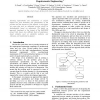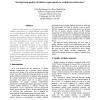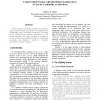ICSE
2003
IEEE-ACM
14 years 11 months ago
2003
IEEE-ACM
Deriving requirements and architecture in concert implies the joint elicitation and specification of the problem and the structure of the solution. In this paper we argue that suc...
ICSE
2003
IEEE-ACM
14 years 11 months ago
2003
IEEE-ACM
Software systems development happens within a context which organizational processes are wellestablished. Hence, software needs to be built with flexible architectures based in so...
ICSE
2003
IEEE-ACM
14 years 11 months ago
2003
IEEE-ACM
The large gap in the levels at which requirements are specified results in inadequate means for ensuring that business goals are properly supported. Architecture-level requirement...
ICSE
2003
IEEE-ACM
14 years 11 months ago
2003
IEEE-ACM
Quality attribute models are proposed as the linkage between a specification of a quality attribute requirement and a design fragment that is focused on achieving that requirement...
ICSE
2003
IEEE-ACM
14 years 11 months ago
2003
IEEE-ACM
Certain classes of problems amenable to description using Problem Frames, in particular ones intended to be implemented using a distributed architecture, can benefit by the additi...
ICSE
2003
IEEE-ACM
14 years 11 months ago
2003
IEEE-ACM
One way to remedy the gap that currently exists between software engineering and human computer interaction is to expose undergraduate students to the ideas, concepts, processes, ...
ICSE
2003
IEEE-ACM
14 years 11 months ago
2003
IEEE-ACM
This paper outlines an approach of using engineeringoriented design theories to build bridges between software engineering and human?computer interaction. The main thrust of the a...
ICSE
2003
IEEE-ACM
14 years 11 months ago
2003
IEEE-ACM
This research has the main objective of presenting a study on the areas of Human-Computer Interaction (HCI) and Software Engineering (SE), focusing on the importance of integratin...
ICSE
2003
IEEE-ACM
14 years 11 months ago
2003
IEEE-ACM
The Unified Modeling Language (UML) has been widely accepted by application developers, but not so much by user interface (UI) designers. For this reason, the Unified Modeling Lan...
ICSE
2003
IEEE-ACM
14 years 11 months ago
2003
IEEE-ACM



